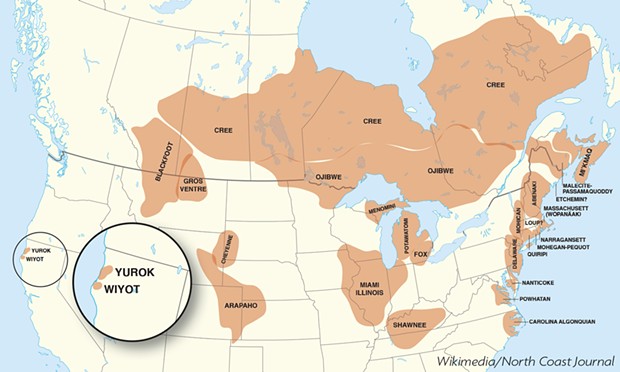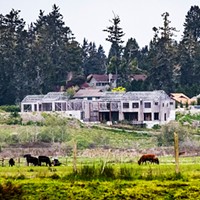
Image by Noahedits, courtesy of Creative Commons, North Coast Journal
Two small, mutually unintelligible, branches of the ancient Algic language are found in Humboldt County.
[
{
"name": "Top Stories Video Pair",
"insertPoint": "7",
"component": "17087298",
"parentWrapperClass": "fdn-ads-inline-content-block",
"requiredCountToDisplay": "1"
}
]
Take a look at the accompanying map, which shows the extent of the so-called "Algic" superfamily of Indigenous languages. (Algic from Allegheny + Atlantic.) Most of these belong to the Algonquian family of about 30 languages, all descended from the Proto-Algonquian that was spoken about 3,000 years ago and whose speakers are now found from the Rocky Mountains to the Atlantic Ocean. However, two Algic languages are located far to the west of the main branch, right here in Humboldt County: Yurok and Soulatluk (from soulatk, meaning jaw), the Wiyot tribal term for their tongue. ("Wiyot" comes from the tribe's name for the Eel River.) Linguists generally agree that the Algic ancestor of the three distinct languages — proto-Algonquian, Yurok and Soulatluk — was spoken about 7,000 years ago. What they don't agree on is where it was spoken. Proposed locations included far-eastern Canada; immediately west of Lake Superior; and the Columbia Plateau stretching across Washington, Oregon and Idaho.
The mystery is this: Yurok and Soulatluk are mutually unintelligible, distinct languages in their own right. Instead of being related to each other in the same way that, for instance, Blackfoot and Cheyenne (two Algonquian languages) are, they are very different. Yet, somehow, Yurok and Soulatluk have maintained their uniqueness through the centuries, despite their speakers living next to each other for a thousand or more years.
Yurok and Soulatluk tribes were surrounded by people speaking completely unrelated languages, in particular those of the Athabaskan (or Na-Dene), a superfamily consisting of about 50 Indigenous languages. According to DNA evidence, Athabaskan arrived later than Algic in the Americas, and most Athabaskan speakers were — and, to some extent, still are — found in Northwest Canada and Alaska. As I've written previously ("Go East, Young May," June 14, 2012), many archeologists and anthropologists now question the conventional "land-bridge from Asia to Alaska" theory, arguing that the ancestors of today's Indigenous people probably used boats to travel south along the "kelp highway" down the Pacific coast: They came by sea, not land.
Curiously, the water route ties in with the controversial claims of the late historian Vine Deloria, best known for Custer Died for Your Sins. In his book Red Earth, White Lies, Deloria argued that Native Americans arrived here via transoceanic travel, in accordance with some of their creation stories. For instance, a tradition of Montana's Blackfoot people is that they formerly lived on the other side of an ocean, while a Hopi belief holds that their ancestors traveled through three worlds, finally crossing the ocean eastward to a new world.
Today, about a dozen Yurok tribal members have full first-language fluency, while many more can speak it as a second language, and an active program is in place to teach it at the primary and secondary school level to any interested students. Soulatluk, on the other hand, has, until recently, been a "sleeping language" following decades of genocide, colonization and forced assimilation. Della Prince, its last known first-language speaker, died in 1962. Prior to her death, University of California Berkeley linguist Karl Teeter worked with Della for four years, building on the work of previous amateur and professional anthropologists and linguists. Thanks to these efforts, the Soulatluk language is mostly well documented and today the 600-member tribe is actively reclaiming its ancestral language.
For more on this, and to hear recordings of Della Prince and other first-language Soulatluk speakers, visit www.wiyot.us/157/Language.
Barry Evans (he/him, [email protected]) sends a big hou' (thank you) to Marnie Atkins and Lynnika Butler for explaining Wiyot language lore.
Editor's note: This story has been updated to correct information about the Yurok language classes.Speaking of...
more from the author
-
Doubting Shakespeare, Part 1: Stratfordians vs. anti-Stratfordians
- Apr 25, 2024
-
A Brief History of Dildos
- Apr 11, 2024
-
Eclipse!
- Mar 28, 2024
- More »
Latest in Field Notes
Readers also liked…
-
Trouble on the Line: The Reality Part 2
- Nov 3, 2022



































